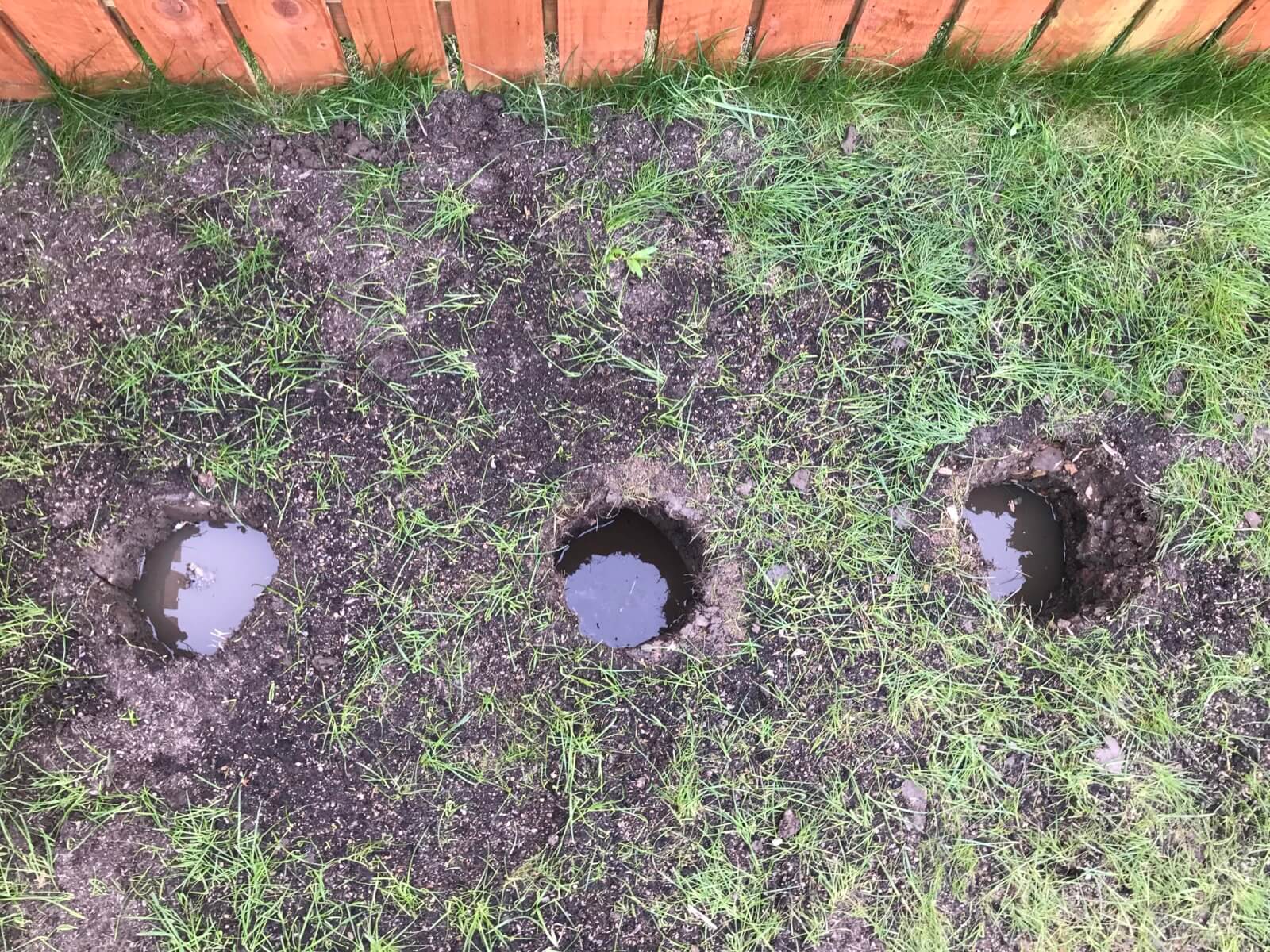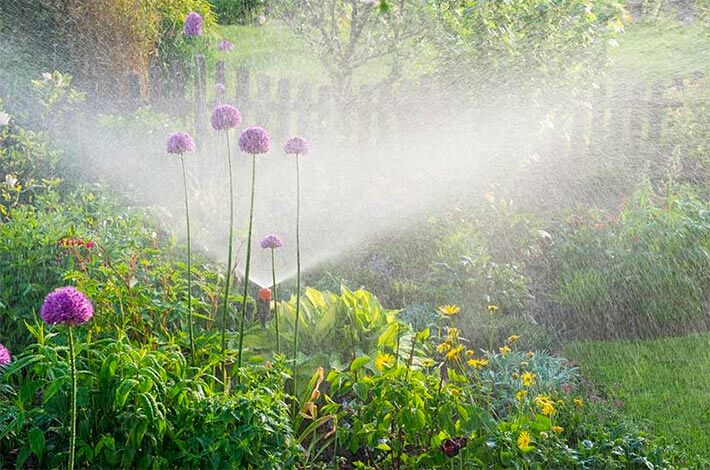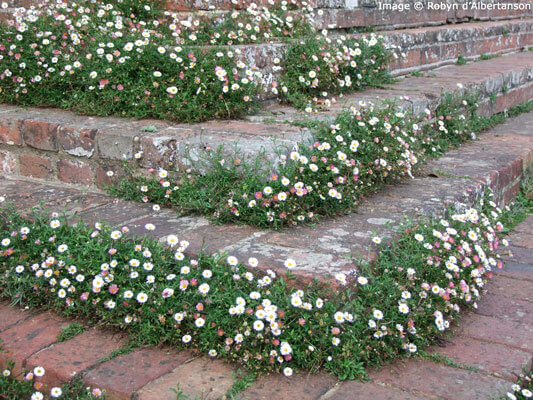How to Water a Garden Properly
Many people worry about how to water their garden properly and get caught out by the sudden changes in weather such as we have seen this Spring- a shift from endless rain to hot sun and drying winds can cause all sorts of problems. So here is a simple guide and a few tips on how to water a garden – it really is not rocket science!

Why watering a garden matters
Watering your plants as needed is probably the most important thing for you to manage in your garden. It is easy to worry about pruning and shaping, and such dark arts as “feeding” or “lifting and dividing” or even weeding, but your plants rarely die if you get those wrong, (and usually you have time to fix things) whereas drying out and waterlogging can kill things fast.
Plants need water to create sugar through photosynthesis, to move nutrients through from roots to leaves, and to retain cell rigidity (hence wilting when dry). Wilting is often the first sign something is going wrong, but plants with more “reinforced” cell structures- bark and waxy leaf coverings for example-may not show they are in trouble until they are going brown and crispy, by which time it can be too late.

Overwatering versus underwatering
The trouble is that plants also need to take up oxygen from their roots, and this usually comes from the small air pockets between soil particles. If they are sitting in water, this drives out the air and literally drowns the plant. Some plants (pond plants or “marginal” plants) are specially designed to sit in water and have mechanisms to still take up oxygen, but pretty much all garden plants cannot cope with more than an occasional waterlogging. Overwatering plants is therefore as big a problem as underwaterering.

Aims when you water a garden
As a rule, unless you are growing plants that particularly like things damp or dry, you are aiming for lightly moist at all times when you water a garden. That means when you push a finger or a stick into the soil around the rootball it will feel a bit damp, although with larger tree specimens it is generally advisable to water thoroughly 2-3 times a week and let them dry out a bit more in between so that the roots are encouraged to grow out and seek moisture. On average it is better to try to keep the soil this way than alternately drown and desiccate, hence the widespread use of dripper systems.
If you are using a hose, sprinkling on the surface in hot weather may lead to a lot of evaporation and run-off and not much water getting down to the roots, so doing it thoroughly and in the cooler part of the day when you do it is best. If you dig a hole and it stays filled with water you definitely have a drainage problem, and few plants will tolerate sitting in that.


So how to tell the difference between over and underwatering
Half the battle is pure common sense and looking hard. On a single view, straight after you water a garden it may be hard to tell, but over a period of a week or so you should be able to see if the soil has remained moist or not. In my experience, most plants are underwatered in the early part of spring when the weather first turns from cold and wet to hot and dry- this often catches people out (particularly with new trees and hedging) and you do need to get out there and check your plants. If you have an irrigation system you will need to get it on, and quite possibly adjust it a fair bit in the first few weeks to get the right level.
Irrigation takes much of the stress out of watering a garden, but it is not foolproof – you still need to take a walk around the garden and see how things are doing. Make sure it is all working after the winter break (pipes break and become clogged, drippers and pop ups move or come loose…animals chew things…), and see how different parts of the garden are faring. Later in the year, particularly as things cool towards Autumn, over-watering is more common.

Whilst the signs are similar between the 2, some things to look for are:
1. YOUR PLANT IS WILTING BUT IT LOOKS LIKE IT HAS PLENTY OF WATER- its probably overwatered
2. THE TIPS OF THE LEAVES TURN BROWN- very common symptom of overwatering
3. LEAVES TURN BROWN AND WILT- happens with both, but too little water will result in the leaves feeling crispy when you hold them in your hand. Too much water and the leaves will feel soft and limp in your hand.
4. BLISTERS- when roots of plants absorb more water than they can use, water pressure begins to build in the cells of the leaves which form blisters. Tan, brown or white warty growths also form.
5. YELLOW LEAVES- this can happen with either, but stunted slow growth with yellowing leaves is a symptom of overwatering.
6. LEAF FALL- similarly occurs in both situations. When both young and old leaves are falling prematurely combined with buds not opening, this is often a sign of too much water.
Check your soil regularly. Don’t be afraid to push you finger into the soil and see how moist it is an inch or two down. If the soil is moist and you have some of the conditions above it’s a sign to reduce your water.

What to do about the problem
Sometimes simply watering (or stopping watering!) is all you need to do. Adding an irrigation system is brilliant for watering a garden if you don’t have time to water regularly, or are often away during the summer.
It also makes sense to plant to suit your location – whilst we often do “push the envelope” a bit on what planting we choose for our gardens so that we can have the plants we like, if these are struggling we can shift the planting to better suit the natural conditions. If your soil is dry then you are better to plant those that are tolerant of this – a quick rule of thumb is that pretty much all grey leaved planting (such as lavender and olives) will prefer things dry…

… and anything you see growing in cracks and walls (such as Erigeron, below) will also do well on crusty dry soils.

There are plenty of plants happy in moist waterlogged soils, and many marginal plants will do well here such as Iris sibirica ….

….and Arum Lily (Zantedeschia) – you have more of a problem if the ground alternates between boggy and dry as many clay soils do, and here it is definitely worth working on the soil conditions.

If the soil is either dry and dusty or clumpy and rock hard in summer you need to increase the water content. In both cases it will help you to improve the soil structure- breaking up a clay soil with grit or organic compost will improve the drainage (reducing winter waterlogging) and the latter will help retain moisture in the summer. With really heavy soils you may need to take more significant action by adding drainage channels. If you have a layer of clay somewhere just below the topsoil you will need to break though this somewhere if it is to drain- sometimes vertical drainage cores can be created through the layer- you may need to dig a pit to see what is going on underneath and form a strategy!
Adding a mulch (a layer of compost or rotted manure) over the top of your planted areas is almost always beneficial- keeping weeds down, moisture in, and gradually improving the soil as it works its way in.
Many of these actions can be done as a simple DIY task, or you are welcome to ask us to have a look and advise. We can advise on garden maintenance including planting, diagnose problems, install, repair and refurbish irrigation systems, carry out drainage remediation, and spread mulches.
